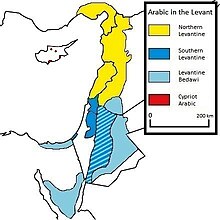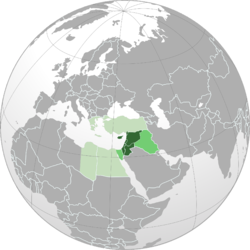| Levant | |
|---|---|
Countries and regions of the Levant in its broad, historical meaning (equivalent to the Eastern Mediterranean) Countries of the Levant in 20th-century usage Countries and regions sometimes included in 21st-century usage | |
| Countries and regions | Narrow definition:
Broad definition: |
| Population | Narrow definition: 44,550,926 |
| Demonym | Levantine |
| Languages | Arabic, Aramaic, Armenian, Circassian, Domari, Greek, Hebrew, Kurdish, Turkish |
| Time Zones | UTC+02:00 (EET) and UTC+03:00 (TRT/AST) |
The Levant (/ləˈvænt/ lə-VANT) is an approximate historical geographical term referring to a large area in the Eastern Mediterranean region of West Asia and core territory of the political term Middle East. In its narrowest sense, which is in use today in archaeology and other cultural contexts, it is equivalent to Cyprus and a stretch of land bordering the Mediterranean Sea in western Asia: i.e. the historical region of Syria ("Greater Syria"), which includes present-day Israel, Jordan, Lebanon, Syria, the Palestinian territories and most of Turkey southwest of the middle Euphrates. Its overwhelming characteristic is that it represents the land bridge between Africa and Eurasia. In its widest historical sense, the Levant included all of the Eastern Mediterranean with its islands; that is, it included all of the countries along the Eastern Mediterranean shores, extending from Greece in Southern Europe to Cyrenaica, Eastern Libya in Northern Africa.
In the 13th and 14th centuries, the term levante was used for Italian maritime commerce in the Eastern Mediterranean, including Greece, Anatolia, Syria-Palestine, and Egypt, that is, the lands east of Venice. Eventually the term was restricted to the Muslim countries of Syria-Palestine and Egypt. The term entered English in the late 15th century from French. It derives from the Italian levante, meaning "rising", implying the rising of the Sun in the east, and is broadly equivalent to the term al-Mashriq (Arabic: ٱلْمَشْرِق, [ʔal.maʃ.riq]), meaning "the eastern place, where the Sun rises".
In 1581, England set up the Levant Company to trade with the Ottoman Empire. The name Levant States was used to refer to the French mandate over Syria and Lebanon after World War I. This is probably the reason why the term Levant has come to be used more specifically to refer to modern Syria, Lebanon, Palestine, Israel, Jordan, and Cyprus. Some scholars mistakenly believed that it derives from the name of Lebanon. Today the term is often used in conjunction with prehistoric or ancient historical references. It has the same meaning as "Syria-Palestine" or Ash-Shaam (Arabic: ٱلشَّام, /ʔaʃ.ʃaːm/), the area that is bounded by the Taurus Mountains of Turkey in the north, the Mediterranean Sea in the west, the north Arabian Desert and Mesopotamia in the east, and Sinai in the south (which can be fully included or not). Typically, it does not include Anatolia (also called Asia Minor), the Caucasus Mountains, or any part of the Arabian Peninsula proper. Cilicia (in Asia Minor) and the Sinai Peninsula (Asian Egypt) are sometimes included.
As a name for the contemporary region, several dictionaries consider Levant to be archaic today. Both the noun Levant and the adjective Levantine are now commonly used to describe the ancient and modern culture area formerly called Syro-Palestinian or Biblical: archaeologists now speak of the Levant and of Levantine archaeology; food scholars speak of Levantine cuisine; and the Latin Christians of the Levant continue to be called Levantine Christians.
The Levant has been described as the "crossroads of Western Asia, the Eastern Mediterranean, and Northeast Africa", and in geological (tectonic) terms as the "northwest of the Arabian Plate". The populations of the Levant share not only the geographic position, but cuisine, some customs, and history. They are often referred to as Levantines.
Etymology

The term Levant appears in English in 1497, and originally meant 'the East' or 'Mediterranean lands east of Italy'. It is borrowed from the French levant 'rising', referring to the rising of the sun in the east, or the point where the sun rises. The phrase is ultimately from the Latin word levare, meaning 'lift, raise'. Similar etymologies are found in Greek Ἀνατολή Anatolē (cf. Anatolia 'the direction of sunrise'), in Germanic Morgenland (lit. 'morning land'), in Italian (as in Riviera di Levante, the portion of the Liguria coast east of Genoa), in Hungarian Kelet ('east'), in Spanish and Catalan Levante and Llevant, ('the place of rising'), and in Hebrew מִזְרָח mizraḥ ('east'). Most notably, "Orient" and its Latin source oriens meaning 'east', is literally "rising", deriving from Latin orior 'rise'.
The notion of the Levant has undergone a dynamic process of historical evolution in usage, meaning, and understanding. While the term "Levantine" originally referred to the European residents of the eastern Mediterranean region, it later came to refer to regional "native" and "minority" groups.
The term became current in English in the 16th century, along with the first English merchant adventurers in the region; English ships appeared in the Mediterranean in the 1570s, and the English merchant company signed its agreement ("capitulations") with the Ottoman Sultan in 1579. The English Levant Company was founded in 1581 to trade with the Ottoman Empire, and in 1670 the French Compagnie du Levant was founded for the same purpose. At this time, the Far East was known as the "Upper Levant".

In early 19th-century travel writing, the term sometimes incorporated certain Mediterranean provinces of the Ottoman Empire, as well as independent Greece (and especially the Greek islands). In 19th-century archaeology, it referred to overlapping cultures in this region during and after prehistoric times, intending to reference the place instead of any one culture. The French mandate of Syria and Lebanon (1920–1946) was called the Levant states.
Geography and modern-day use of the term

Today, "Levant" is the term typically used by archaeologists and historians with reference to the history of the region. Scholars have adopted the term Levant to identify the region due to its being a "wider, yet relevant, cultural corpus" that does not have the "political overtones" of Syria-Palestine. The term is also used for modern events, peoples, states or parts of states in the same region, namely Cyprus, Egypt, Iraq, Israel, Jordan, Lebanon, Palestine, Syria, and Turkey are sometimes considered Levant countries (compare with Near East, Middle East, Eastern Mediterranean and West Asia). Several researchers include the island of Cyprus in Levantine studies, including the Council for British Research in the Levant, the UCLA Near Eastern Languages and Cultures department, Journal of Levantine Studies and the UCL Institute of Archaeology, the last of which has dated the connection between Cyprus and mainland Levant to the early Iron Age. Archaeologists seeking a neutral orientation that is neither biblical nor national have used terms such as Levantine archaeology and archaeology of the Southern Levant.
While the usage of the term "Levant" in academia has been restricted to the fields of archeology and literature, there is a recent attempt to reclaim the notion of the Levant as a category of analysis in political and social sciences. Two academic journals were launched in the early 2010s using the word: the Journal of Levantine Studies, published by the Van Leer Jerusalem Institute and The Levantine Review, published by Boston College.
The word Levant has been used in some translations of the term ash-Shām as used by the organization known as ISIL, ISIS, and other names, though there is disagreement as to whether this translation is accurate.
In archaeology: a definition
In The Oxford Handbook of the Archaeology of the Levant: c. 8000–332 BCE (OHAL; 2013), the definition of the Levant for the specific purposes of the book is synonymous to that of the Arabic "bilad al-sham, 'the land of sham [Syria]'", translating in Western parlance to greater Syria. OHAL defines the boundaries of the Levant as follows.
- To the north: the Taurus Mountains or the Plain of 'Amuq
- To the east: the eastern deserts, i.e. (from north to south) the Euphrates and the Jebel el-Bishrī area for the northern Levant, followed by the Syrian Desert east of the eastern hinterland of the Anti-Lebanon range (whose southernmost part is Mount Hermon), and Transjordan's highlands and eastern desert (also discussed at Syrian Desert, also known as the Badia region).[5] In other words, Mesopotamia and the North Arabian Desert.
- To the south: Wadi al-Arish in Sinai
- To the west: the Mediterranean Sea
- Subregions
A distinction is made between the main subregions of the Levant, the northern and the southern:
- The Litani River marks the division between the Northern Levant and the Southern Levant.
The island of Cyprus is also included as a third subregion in the archaeological region of the Levant:
- Cyprus, geographically distinct from the Levant, is included due to its proximity and natural resources (copper in particular), which induced close cultural ties.
History
Demographics
Religious and ethnic groups
| Year | Pop. | ±% |
|---|---|---|
| 14 | 4,300,000 | — |
| 164 | 4,800,000 | +11.6% |
| 500 | 4,127,000 | −14.0% |
| 900 | 3,120,000 | −24.4% |
| 1200 | 2,700,000 | −13.5% |
| 1700 | 2,028,000 | −24.9% |
| 1897 | 3,231,874 | +59.4% |
| 1914 | 3,448,356 | +6.7% |
| 1922 | 3,198,951 | −7.2% |
The vast majority of Levantines are Muslims. After the Muslim conquest of the Levant in the 7th century, Islam was first introduced into the region. However, a Muslim majority in the Levant is presumed to have been reached by the 13th century. The majority of Levantine Muslims are Sunnis adhering to the four madhhabs (Hanafi, Shafi'i, Hanbali and Maliki). Islamic minorities include the Alawites and Nizari Ismailis in Syria, and Twelver Shiites in Lebanon.
Levantine Christian groups include Greek Orthodox (Antiochian Greek), Syriac Orthodox, Eastern Catholic (Syriac Catholic, Melkite and Maronite), Roman Catholic (Latin), Nestorian, and Protestant. Armenians mostly belong to the Armenian Apostolic Church. There are also Levantines or Franco-Levantines who adhere to Roman Catholicism. There are also Assyrians belonging to the Assyrian Church of the East and the Chaldean Catholic Church.
Other religious groups in the Levant include Jews, Samaritans, Yazidis and Druze.
Languages

Most populations in the Levant speak Levantine Arabic (شامي, Šāmī), a variety of Arabic descended from the pre-Islamic Arabic dialects of Syria and Hejazi Arabic, but retains significant influence from Western Middle Aramaic. Levantine Arabic is usually classified as North Levantine Arabic in Lebanon, Syria, and parts of Turkey, and South Levantine Arabic in Palestine and Jordan. Each of these encompasses a spectrum of regional or urban/rural variations. In addition to the varieties normally grouped together as "Levantine", a number of other varieties and dialects of Arabic are spoken in the Levant area, such as Levantine Bedawi Arabic (by Bedouins) and Mesopotamian Arabic (in eastern Syria).
Of the languages of Cyprus, the two official languages are Turkish and Greek. The most used languages by population are Greek in the south followed by Turkish in the north. Two minority languages are recognized: Armenian, and Cypriot Maronite Arabic, a hybrid of mostly medieval Arabic vernaculars with strong influence from contact with Turkish and Greek, spoken by approximately 1,000 people.
Western Neo-Aramaic is additionally spoken in three villages in Syria: Maaloula, Jubb'adin and Bakhah.
Among diaspora communities based in the Levant, Greek, Armenian and Circassian are also spoken.
Genetics
According to recent ancient DNA studies, Levantines derive most of their ancestry from ancient Semitic-speaking peoples of the Bronze and Iron age Levant. Other Arabs include the Bedouins of Syrian Desert, Naqab and eastern Syria, who speak Bedouin Arabic. Non-Arab minorities include Circassians, Chechens, Turks, Jews, Turkmens, Assyrians, Kurds, Nawars and Armenians.

